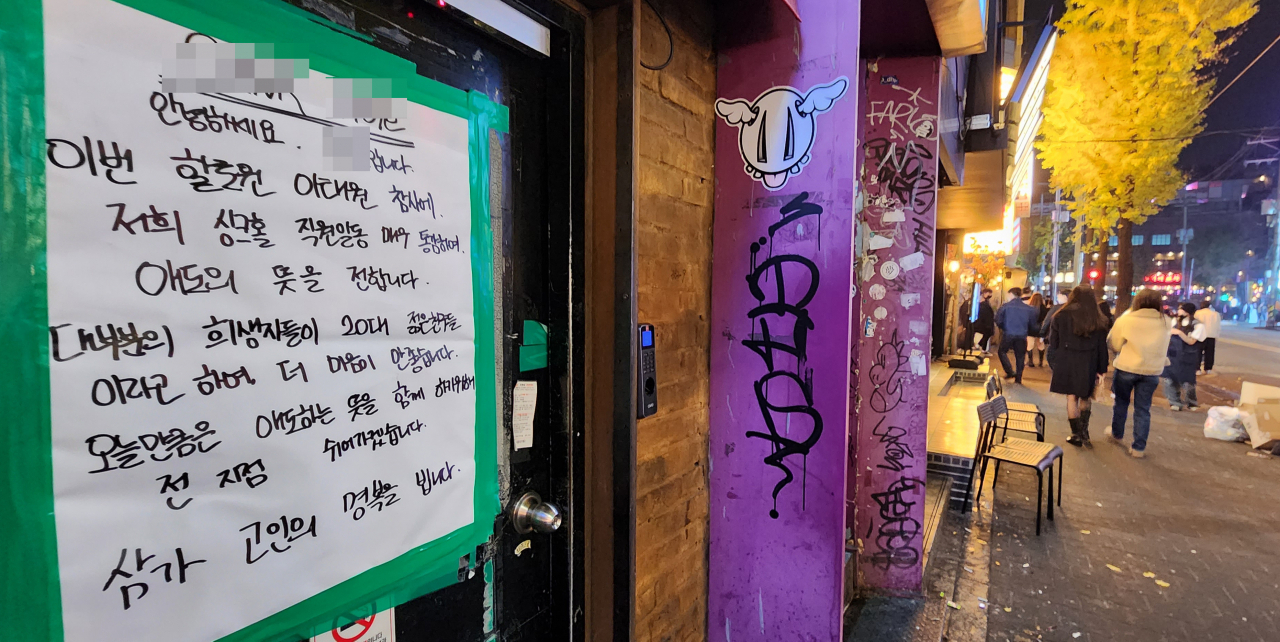 |
A business in Hongdae, Seoul, put up a sign on Sunday saying it would halt operations to pay tribute to the victims of Saturday's tragedy (Yonhap) |
South Korea’s consumer spending is expected to weaken further as the nation reels from the crowd surge tragedy in Itaewon that took over 150 lives, similar to over eight years ago after the Sewol ferry sinking that killed over 300 people, mostly teenagers on a school trip.
As the economy is already projected to post zero percent growth or shrink in the last quarter of this year amid sluggish exports, some observers say the Itaewon disaster could hasten a recession.
In the weeks following the ferry accident on April 16, 2014, traumatized and depressed Koreans spent significantly less, resulting in slowed economic growth.
According to Finance Ministry data at the time, the on-year growth of credit card spending went from 25 percent on April 14 and 15 to 6.9 percent on April 16 through 20, and tumbled further to 1.8 percent in the last week of that month.
Private sector consumption in the first three months of 2014 had grown 0.5 percent from the previous quarter, but fell 0.2 percent in the three months from April.
The deadly accident on Saturday is also likely to depress consumer sentiment as businesses and other organizations have canceled events and gatherings after the government announced this week as a period of national mourning, according to observers.
Should such sentiment continue, the economy, already hit by sluggish exports, inflation, high interest rates and a weak Korean won, could further contract on low private sector consumption, they added.
Statistics Korea data showed on Monday that the country is already seeing a triple decline of industrial output, consumption and investment.
The September industrial output index fell 0.6 percent from the previous month to 117, while the retail sales index, an indicator of spending, dipped 1.8 percent, following a 4.4 percent increase in August, and facility investment dropped by 2.4 percent.
Primary metal production tumbled 15.7 percent as Posco had to stop running its steel mill in Pohang, North Gyeongsang Province, after it was flooded by Typhoon Hinnamnor in early September.
Production of semiconductors, a major export item, also dropped 4.5 percent that month while inventory grew 0.6 percent compared to August, and jumped 54.7 percent from a year ago.
“Semiconductor production dipped in the aftermath of factory shutdowns in China and the overall IT industry slump,” Eoh Woon-sun, a Statistics Korea official in charge of economic statistics, said in a briefing.
September's manufacturing inventory rose 0.2 percent from the previous month, and 9.5 percent from a year prior, largely due to the increased stock of chips.
According to the Bank of Korea, the country’s real gross domestic product in the three months to September inched up 0.3 percent from the previous quarter, slowing down from 0.6 percent in the first quarter and 0.7 percent in the second.
What helped the economy grow, instead of shrinking, in the third quarter despite waning global demand for semiconductors was solid domestic consumption, especially over the Chuseok holidays.
The central bank’s economic statistics director Hwang Sang-pil told reporters last week that the recovery of private sector consumption, which grew in the second and third quarters, is likely to slow due to higher interest rates and inflation.
The October consumer sentiment index, announced by the Bank of Korea last week, fell 2.6 points from the previous month to 88.8. Numbers under 100 indicate a prevailing pessimistic outlook.







